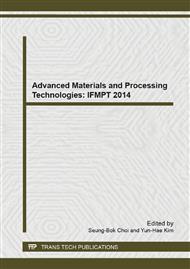[1]
K. Uchino, Ceramic actuators: principles and applications, Mater. Res. Bull. 18 (1993) 42-48.
Google Scholar
[2]
P.K. Panda, Review: environmental friendly lead-free piezoelectric materials, J. Mater. Sci. 44 (2009) 5049-5062.
DOI: 10.1007/s10853-009-3643-0
Google Scholar
[3]
Y.G. Wu, H.L. Zhang, Y. Zhang, Lead-free piezoelectric ceramics with composition of (0. 97-x)Na1/2Bi1/2TiO3-0. 03NaNbO3-xBaTiO3, J. Mater. Sci. 38 (2003) 987-994.
Google Scholar
[4]
Y. Li, K. Moon, C. P. Wong, Electronics without lead, Science 308 (2005) 1419.
Google Scholar
[5]
W. Liu, X. Ren, Large piezoelectric effect in Pb-free ceramics, Phys. Rev. Lett. 103 (2009) 257602.
Google Scholar
[6]
S. Su, R.Z. Zuo, S.B. Lu, Poling dependence and stability of piezoelectric properties of Ba(Zr0. 2Ti0. 8)O3-(Ba0. 7Ca0. 3)TiO3 ceramics with huge piezoelectric coefficients, Curr. Appl. Phys. 11 (2011) S120-123.
DOI: 10.1016/j.cap.2011.01.034
Google Scholar
[7]
Y.P. Pu, H.D. Wu, J.F. Wei, Preparation and positive temperature coefficient of resistivity behavior of Ba0. 95Ca0. 05TiO3-BiYO3-Na0. 5Bi0. 5TiO3 ceramics, Powder. Technol. 219 (2012) 244-248.
DOI: 10.1016/j.powtec.2011.12.053
Google Scholar
[8]
M.S. Yoon, I. Mahmud, Phase-formation, microstructure, and piezoelectric/dielectric properties of BiYO3-doped Pb(Zr0. 53Ti0. 47)O3 for piezoelectric energy harvesting devices, Ceram. Inter. 39 (2013) 8581-8588.
DOI: 10.1016/j.ceramint.2013.04.031
Google Scholar
[9]
C. Zhang, Q.B. Liu, X.Q. Huang, Effect of sintering temperature on microstructure and electrical properties of (Mn, Nb)-doped BZT-BCT ceramics, Adv. Mater. Res. 820 (2013) 59-62.
DOI: 10.4028/www.scientific.net/amr.820.59
Google Scholar
[10]
Z.Y. Cen, H.B. Yang, C.G. Zhou, Effect of sintering temperature on microstructure and piezoelectric properties of Pb-free BiFeO3-BaTiO3ceramics in the composition range of large BiFeO3, J. Electroceram. 31 (2013) 15-20.
DOI: 10.1007/s10832-013-9803-2
Google Scholar
[11]
G. Arlt, The influence of microstructure on the properties of ferroelectricceramics, Ferroelectrics. 104 (1990) 217-227.
Google Scholar


